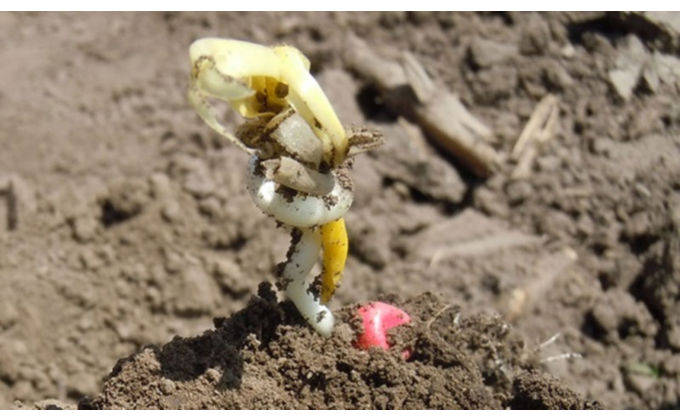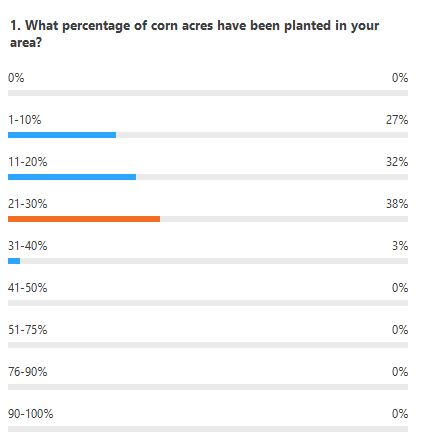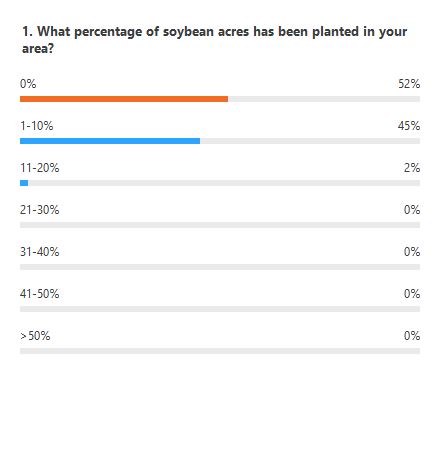As a reminder, participants can join breakfast meetings by phone without using the Zoom app or logging onto the Zoom website by using the number provided in the breakfast meeting listserv.
Corn planting began in earnest on Thursday and continued through Monday. Some producers are nearly done their corn acres, particularly on light ground in Huron County. There have been very few reports of soybean planting to date (less than 5% of acres in the region). Demand for spring cereal seed is high and producers are still looking to switch some corn acres. Potato planting has begun for those with a lot of acres. Soil conditions are very good for planting, although temperatures have been low with nighttime temperatures below zero. Annual weeds are just beginning to emerge. There are reports Canada fleabane is starting to bolt and dandelions starting to flower.
Winter Wheat
Winter survival was good, but with continued cool conditions there is still some purple wheat leaves as reported in the minutes of last week’s meetings. Producers that are split-applying nitrogen have not put their second application on yet, but nitrogen is done on fields getting a single application. Temperatures are now generally above 5°C and weeds are starting to emerge, so herbicides will be applied in the coming weeks. We do not want to stress the crop by applying herbicide at temperatures below 5°C, but if it dips below 5°C after application the yield impact is usually minimal. Recommendations for controlling Canada fleabane in winter wheat are Infinity, Pixxaro + MCPA, or Lontrel. Scouts are watching for T1 fungicide timing and frost-free nighttime temperatures. Models are not yet showing risk of cereal diseases, but it is important to monitor your fields for disease and fungicide timing.
Spring Cereals
Seed is in high demand, and in the past week seed dealers have been filling large orders. Some varieties are sold out, and some dealers are entirely sold out of seed. Oat and barley seed sales are anywhere from 25-40% higher than normal. Corn acres are being switched to spring cereals with growers looking to forward contract spring grain at relatively strong prices. At least 80% of acres have been seeded, particularly in the northern part of the region.
Plant growth regulators (PGRs) are now registered for all types of spring cereals but it is important to check with your buyer whether they will accept grain treated with PGRs, particularly for oats and malting barley. Cereal varieties have different lodging risk and not all varieties respond to PGR application. Review lodging risk for each variety at www.gocereals.ca. You can find more information on oat management HERE and PGRs HERE (both are available in French and English). A recent article on a nitrogen management trial in Ontario spring cereals can be found HERE.
Recommendations for controlling fleabane ahead of planting oats include glyphosate + Eragon or glyphosate + Eragon + 2,4-D. There was a question about controlling Russian knapweed in spring wheat. This weed is very difficult to control in cereals but a product with clopyralid (e.g. Lontrel) might provide some control.
Cereal Leaf Beetle (CLB) Survey
Ontario producers have reported in recent years that CLB levels are increasing and difficult to predict. OMAFRA have created a CLB survey tool and ask that producers and scouts report their cereal crop stages and CLB field observations. Contributions to the survey will provide baseline data on where and when (date and cereal growth stage) CLB are appearing. AAFC will use the data to validate the CLB model used by the Prairie Pest Monitoring Network. If successful, it will help predict CLB development and improve scouting guidelines for Ontario producers. Links to the CLB and cereal staging survey will be provided on Field Crop News within the next week.
Insect Trapping
The Great Lakes and Maritimes Pest Monitoring Network will be running again in 2020. Monitoring will be conducted for black cutworm (BCW), corn earworm (CEW), European corn borer (ECB), fall armyworm (FAW), true armyworm (TAW) and western bean cutworm (WBC). Interactive real-time map and trap data during the season can be observed on a dashboard that summarizes the trap results by pest. Information on the network and trapping instructions for each pest can be found HERE.
Traps in New York have detected true armyworm and black cutworm already this year. Anticipate scouting for larvae in the next two or three weeks in fields that had green vegetation including weeds in the month of April.
Corn
Planters were rolling through the weekend, with about 30% of acres complete in Huron County, less than 10% in Bruce County, and 15-20% complete in Simcoe and Perth counties. Planting conditions are generally very good and soils are relatively dry. A heavy downpour of rain may change the way soils are working up. Hybrids with a maturity of 90 days or less may be in shorter supply this year because of hybrid switching that occurred last year.
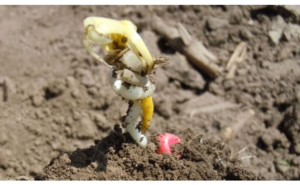
There was discussion about cold rain after planting and germination in cold conditions causing “corkscrewing” of corn seedlings (Figure 1). This can occur when corn seed imbibes water from cold rain falling after planting. Participants at the meeting are hopeful this will not be a major issue in corn planted over the weekend, because although temperatures have been low the soils are relatively dry and not overly saturated. Corn that was planted earlier in the month and has seen snow and frost may show some injury (Figure 2).
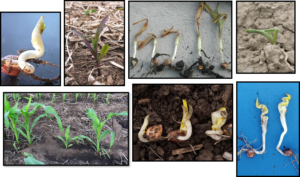
Repeated rain events after application of pre- emerge corn herbicides can increase the risk of crop injury, depending on the active ingredient. Group 15 products and Prowl are examples of herbicides that have a higher risk of injury in this scenario, particularly on light textured soils.
Chapter 1 of the OMAFRA Guide to Weed Control – Pub 75A has information on hard to control weeds, including the following info on Canada fleabane. You can find Pub 75 HERE. Control of glyphosate resistant Canada fleabane has been most consistent with postemergence herbicide applications but good control can be achieved with preemergence herbicides. Of the preemergence herbicides, ACURON, INTEGRITY, MARKSMAN, CALLISTO + AATREX 480 and ENGENIA, FEXAPAN or XTENDIMAX are all good options. Postemergence applications of MARKSMAN, ENGENIA, PARDNER + AATREX 480 and DISTINCT are also effective on glyphosate resistant Canada fleabane. Aggressive primary tillage prior to planting can also be very effective on small fleabane rosettes.
Growers are reminded of European Union (EU) trait approval requirements for exporting corn. There are many individual traits approved for EU export, but separate approval is required for stacked traits, even if their individual traits are approved. Not all stacked traits available in Ontario are EU approved, and some non-approved hybrids have become more popular recently. Given Ontario corn is exported to EU, growers should verify for EU approval with seed suppliers and end-users as some are posting restrictions on hybrids not accepted in EU. To verify what hybrids are approved, select “grid view”, and look for check marks under the “EU Approved” column at the Canadian Seed Trade Association (CSTA) corn hybrid database. Following restrictions ensures we maintain market access. A joint statement from Ontario Agri Business Association and Grain Farmers of Ontario can be found HERE.
Soybeans
Planting progress is reported to be 5% or less. Some reported that corn stalks are brittle and soil conditions are very good. Annual weeds are just starting to emerge so “burndown” herbicide applications are not yet complete.
Canola
Planting is in the very early stages in Northern Ontario but is 75-80% complete in Bruce County. It is estimated that more than half of canola acres in Wellington, Grey and Simcoe counties are also complete.
Winter canola is bolting and green buds are visible, but it has not flowered yet. Producers should watch for cabbage seedpod weevil now through early pod formation. Information on cabbage seedpod weevil found HERE is applicable to both spring and winter canola.
